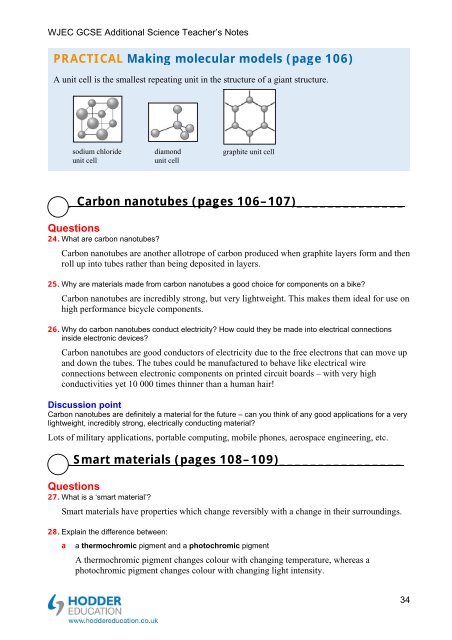Teacher's notes and answers to questions in the book - Hodder Plus ...
Teacher's notes and answers to questions in the book - Hodder Plus ...
Teacher's notes and answers to questions in the book - Hodder Plus ...
You also want an ePaper? Increase the reach of your titles
YUMPU automatically turns print PDFs into web optimized ePapers that Google loves.
WJEC GCSE Additional Science Teacher’s Notes<br />
PRACTICAL Mak<strong>in</strong>g molecular models (page 106)<br />
A unit cell is <strong>the</strong> smallest repeat<strong>in</strong>g unit <strong>in</strong> <strong>the</strong> structure of a giant structure.<br />
sodium chloride<br />
unit cell<br />
diamond<br />
unit cell<br />
graphite unit cell<br />
_ Carbon nanotubes (pages 106–107)______________<br />
Questions<br />
24. What are carbon nanotubes<br />
Carbon nanotubes are ano<strong>the</strong>r allotrope of carbon produced when graphite layers form <strong>and</strong> <strong>the</strong>n<br />
roll up <strong>in</strong><strong>to</strong> tubes ra<strong>the</strong>r than be<strong>in</strong>g deposited <strong>in</strong> layers.<br />
25. Why are materials made from carbon nanotubes a good choice for components on a bike<br />
Carbon nanotubes are <strong>in</strong>credibly strong, but very lightweight. This makes <strong>the</strong>m ideal for use on<br />
high performance bicycle components.<br />
26. Why do carbon nanotubes conduct electricity How could <strong>the</strong>y be made <strong>in</strong><strong>to</strong> electrical connections<br />
<strong>in</strong>side electronic devices<br />
Carbon nanotubes are good conduc<strong>to</strong>rs of electricity due <strong>to</strong> <strong>the</strong> free electrons that can move up<br />
<strong>and</strong> down <strong>the</strong> tubes. The tubes could be manufactured <strong>to</strong> behave like electrical wire<br />
connections between electronic components on pr<strong>in</strong>ted circuit boards – with very high<br />
conductivities yet 10 000 times th<strong>in</strong>ner than a human hair!<br />
Discussion po<strong>in</strong>t<br />
Carbon nanotubes are def<strong>in</strong>itely a material for <strong>the</strong> future – can you th<strong>in</strong>k of any good applications for a very<br />
lightweight, <strong>in</strong>credibly strong, electrically conduct<strong>in</strong>g material<br />
Lots of military applications, portable comput<strong>in</strong>g, mobile phones, aerospace eng<strong>in</strong>eer<strong>in</strong>g, etc.<br />
_Smart materials (pages 108–109)________________<br />
Questions<br />
27. What is a ‘smart material’<br />
Smart materials have properties which change reversibly with a change <strong>in</strong> <strong>the</strong>ir surround<strong>in</strong>gs.<br />
28. Expla<strong>in</strong> <strong>the</strong> difference between:<br />
a a <strong>the</strong>rmochromic pigment <strong>and</strong> a pho<strong>to</strong>chromic pigment<br />
A <strong>the</strong>rmochromic pigment changes colour with chang<strong>in</strong>g temperature, whereas a<br />
pho<strong>to</strong>chromic pigment changes colour with chang<strong>in</strong>g light <strong>in</strong>tensity.<br />
34

















